jupiter
Latest
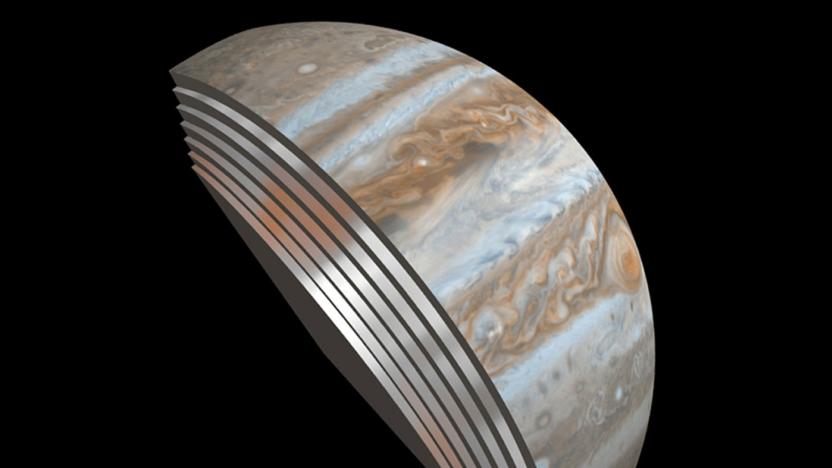
NASA's Juno probe napped through its latest Jupiter flyby
NASA's Jupiter probe was supposed gather data when it did a close flyby of the gas giant a few days ago. Alas, it suddenly switched off all its scientific instruments as it unexpectedly entered safe mode due to some engine troubles. Thankfully, it was a temporary setback: Juno is now back and ready to do science the next time it's scheduled to soar close to the planet (December 11th).

Juno's misbehaving engine means a change of plans around Jupiter
Three months ago, the Juno probe ended a years-long journey when it settled into orbit around Jupiter. Everything's just peachy with Juno's cameras -- as evidenced by these magnificent photos -- but it turns out its primary Leros 1b engine is having trouble. In preparation for a burn that would put Juno into its final orbit around the gas giant, the team at NASA's Jet Propulsion Laboratory punched up a sequence of commands late last week and saw (via telemetry) that a pair of helium check valves weren't working correctly.

ICYMI: Roller coasters will be recommended by urologists
try{document.getElementById("aol-cms-player-1").style.display="none";}catch(e){}Today on In Case You Missed It: Researchers at Michigan State created a lifelike 3D model of a patient's kidney, with stones inside, and took it on a roller coaster after the man said the crystals cleared after riding Big Thunder Mountain. Turns out, the model backed it up and now, doctors will probably start recommending folks with smaller kidney stones ride roller coasters as treatment. The inner child of every adult just did a happy dance.
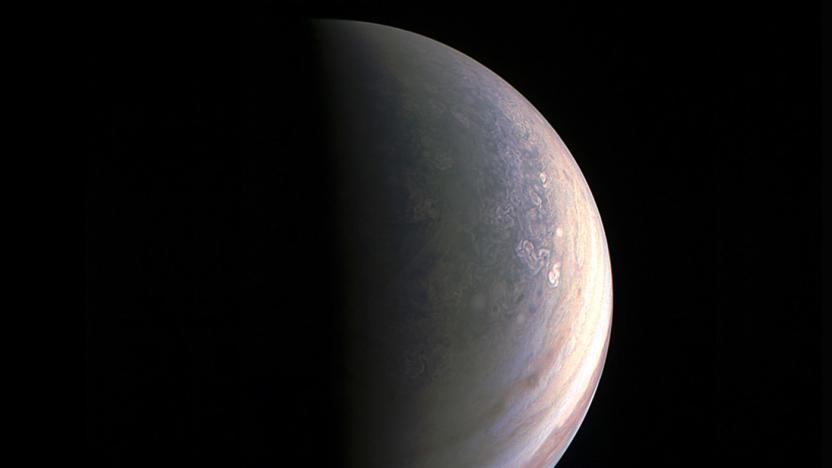
Juno sends back a rare view of Jupiter's north pole
When someone mentions the planet Jupiter, you probably think of the image we're all familiar with: that one with a view of its equator, bands and the Great Red Spot. That's why the photos above and below the fold might look like an alien world, when in reality, they're snapshots of the gas giant from a different angle. NASA's Juno spacecraft captured the planet's north polar region on cam two hours before its closest approach in late August. It was 120,000 miles away when the JunoCam took these pics, but it got as close as 2,600 miles above Jupiter's surface. The last time we caught a glimpse of the gas giant's polar region was back in 1974 when the Pioneer 11 probe passed by.

Juno probe makes the closest-ever encounter with Jupiter
If you thought the Juno probe's first photos of Jupiter were tantalizing, you're in for a treat. The spacecraft just completed the closest approach it will take during its primary mission around the gas giant, passing a mere 2,600 miles above the surface early on the 26th. It's the closest any vehicle has been to Jupiter, and NASA researchers already believe that they'll discover new things about the Jovian world once they process the data (which could take "some time," NASA warns). And of course, it's a prime photographic opportunity. You'll not only get the sharpest-ever photos of Jupiter's atmosphere when photos arrive late next week, but the first good look at the planet's poles.
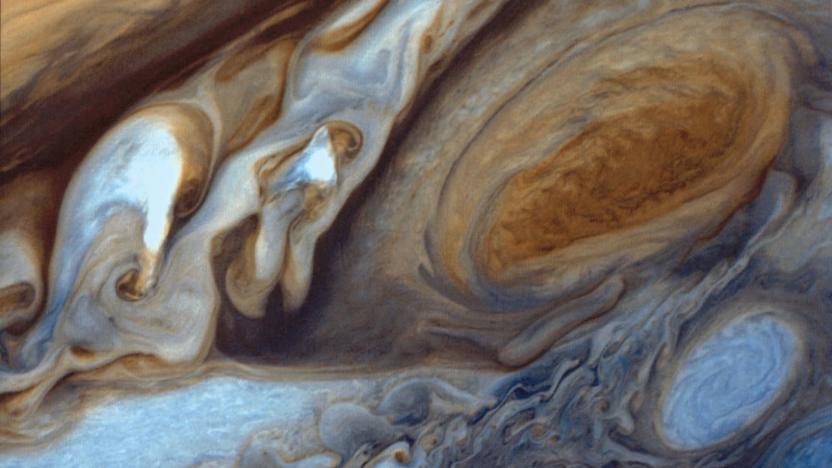
Researchers believe Jupiter's Red Spot is heated by thunder
Despite its distance from the sun, Jupiter is a surprisingly hot planet with temperatures ranging around 1,000 degrees Fahrenheit in the middle latitudes. According to new findings published today in the journal Nature, temperatures over the planet's Great Red Spot can range even higher -- up to about 2,500 degrees Fahrenheit, or 1,300 degrees Celsius. And the researchers behind the new study believe they may have finally figured what's feeding the extreme temperatures around the 10,000-mile-wide storm.
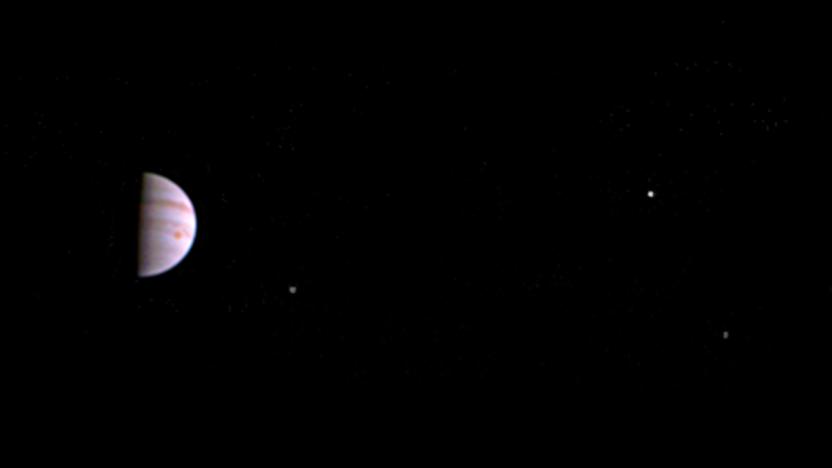
Juno sends back first photos from Jupiter's orbit
With Jupiter being some 365 million miles from Earth at its closest point, it can take awhile to send information from beyond the asteroid belt and back to Earth. On July 10th, just six days after arriving in Jupiter's orbit, NASA flipped on Juno's main visible light camera "JunoCam" and started snapping pictures. Now, just a couple days later, and we've got JunoCam's first shots of the largest planet in the solar system.

Juno has begun its tour of Jupiter after a five-year journey
Juno's five-year journey has come to an end, and soon, it will start taking measurements and capturing images of the largest planet in our solar system. The spacecraft, which aptly carries Lego figures of the Roman god Jupiter, his wife the goddess Juno and Galileo, has entered Jupiter's orbit after firing up its engines before midnight and performing a 35-minute maneuver. That was much harder to accomplish than it sounds -- it had to be at the right speed to be captured by the gas giant's gravity, or it would have slipped right past it. In the end, everything went well, and the spacecraft's arrival was off only by a second.

How to watch NASA's Juno spacecraft enter Jupiter's orbit
NASA launched its Jupiter-exploring Juno spacecraft on August 5, 2011, but thanks to some patriotic timing, it's arriving at the gas giant today on July 4th. That'll give space fans some additional fireworks, as NASA and JPL will be broadcasting the crucial orbit insertion starting at around 10:30 PM ET. If all goes well, the craft will fire its main engine for 35 minutes and scrub 1,212 mph from its current 37,000 mph velocity. That'll give it just the right speed to be captured into a 53-day orbit around the planet.
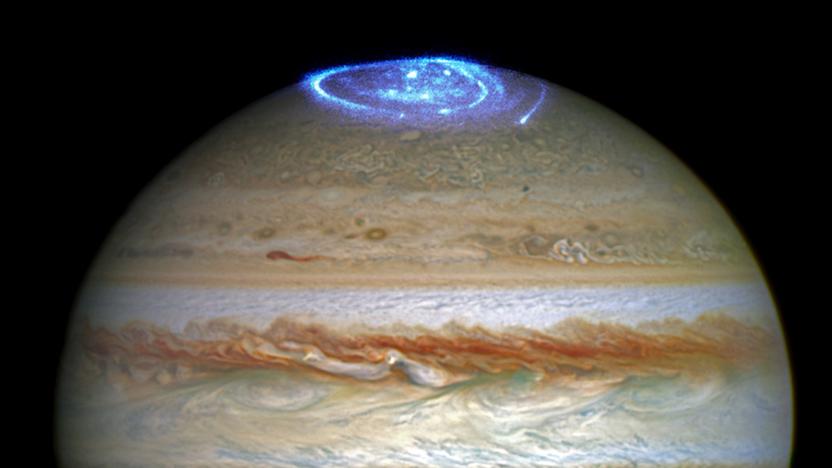
Hubble photographs Jupiter's dramatic auroras
The wispy, glowing veil sitting on top of Jupiter in the image above is actually a humongous aurora captured on cam by Hubble. A team of astronomers are using the telescope's ultraviolet instruments to study nature's light shows on the poles of the gas giant. They timed their study to coincide with Juno's arrival on the planet, since one of their goals is to determine how different solar wind conditions and other factors affect Jupiter's auroras. The spacecraft is in charge of measuring various solar wind properties, while they continue capturing images and videos almost every day during the duration of the mission.

Trent Reznor and Atticus Ross made a song for NASA's Juno mission
Nine Inch Nails frontman and Apple Music contributor Trent Reznor has another project with his film soundtrack partner Atticus Ross. This time around, the duo has created a nearly 9-minute track to celebrate NASA's Juno mission to Jupiter. The single song is available now on iTunes ahead of the probe's scheduled July 4th arrival in the planet's orbit. NASA's solar-powered spacecraft was launched five years ago, but soon it'll arrive at Jupiter to begin the task of measuring, studying and photographing the planet. For a behind-the-scenes look at the mission, check out our recent Juno feature.
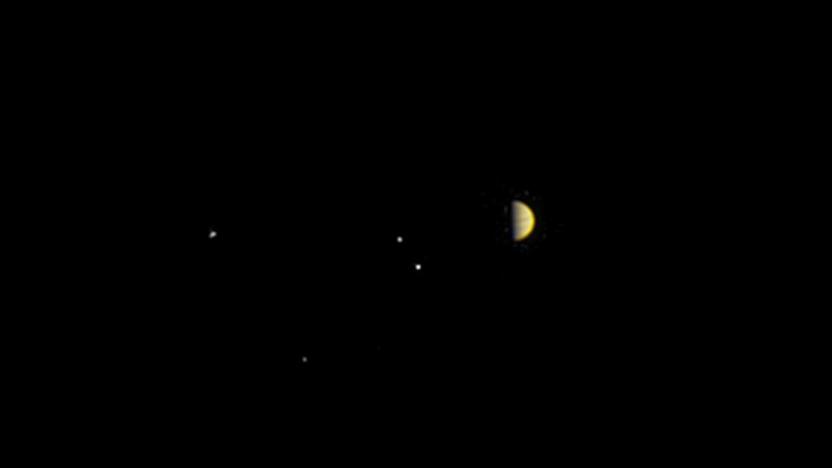
Juno snaps a pic of Jupiter before it reaches the gas giant
NASA's Juno spacecraft is diving into Jupiter's orbit in a few days' time, five years after it blasted off its launching pad in Cape Canaveral. The gas giant is merely a stone's throw away, and this image captured by the probe's camera, the JunoCam, shows just how close it is to reaching its destination. Juno took a photo of the planet and its four biggest moons on June 21st, while it was 6.8 million miles away. That might sound like it's still awfully far, but don't forget that the probe will have traveled 1.74 billion miles by the time it enters Jupiter's orbit on July 4th. JunoCam could only manage a hazy photo at that point in time, but you can still make out Jupiter's bands. You can also see four dots on one side of the picture, which are actually the Galilean satellites Io, Europa, Ganymede and Callisto.

Juno: An inside look at NASA's mission to Jupiter
Juno is going where no spacecraft has before. NASA's solar-powered ship was launched five years ago, sent on a mission to study Jupiter, the largest gas globe in our solar system. Now, after almost a couple thousand days on course, it is on track to arrive at Jupiter on the evening of July 4th to scan, measure, study and photograph the planet. On a recent trip to the Jet Propulsion Laboratory (JPL) headquarters in Pasadena, I caught up with lead project scientist Steve Levin for a rundown of the mission and the specific event that could potentially uncover the mysteries of our entire solar system.
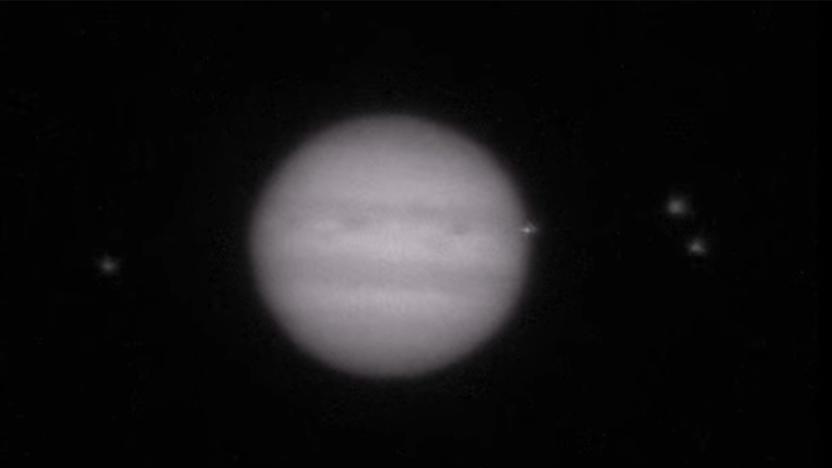
Amateur astronomers caught a Jupiter impact on camera
Jupiter gets hit by wayward celestial objects surprisingly often (about once per year), but you'd be forgiven if you didn't know it. Not all of them are visible, and professionals can only observe so much. However, the rise in readily accessible astronomy tech just helped detect one of these encounters. Amateur astronomers from Austria and Ireland have recorded videos showing that something, most likely an asteroid or comet, struck Jupiter on March 17th. The collision only lasted for a split second (blink and you'll miss it in the videos below) but it was ferocious -- even if the object was only a few hundred feet across, Jupiter's intense gravity guaranteed a high-velocity impact that would be visible from Earth.
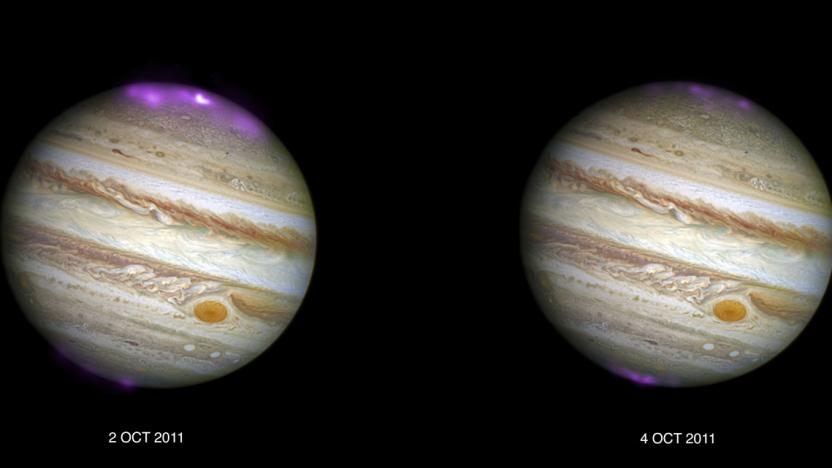
Solar storms trigger X-ray auroras on Jupiter
It's no secret that auroras are a common presence on other planets... however, you might be surprised by the ones you can't usually see. A new study using NASA's Chandra X-ray Observatory has caught solar storms creating X-ray auroras on Jupiter as they interacted with the gas giant's magnetosphere (that is, the space controlled by its magnetic field). They make Earth's northern lights seem downright quaint by comparison -- they cover areas larger than our entire home planet, and they're "hundreds of times" more energetic than what you see in the night sky.

Juno sets distance record for solar-powered spacecraft
Aided by its enormous solar array, NASA spacecraft Juno has set a record as the most distant solar-powered space explorer. The four ton "armored tank" craft hit 493 million miles yesterday on its way to Jupiter, passing Rosetta's 492-million-mile mark. With a 30-foot-long array and 18,698 solar cells, it's able to profit from what little sunlight hits it. "Jupiter is five times farther from the sun than Earth, and the sunlight that reaches that far out packs 25 times less punch," said Juno project manager Rick Nybakken.

Astronomers spot a star with a Jupiter-like storm
Unfathomably large storms aren't reserved solely for gas giants like Jupiter... they can exist on stars, too. Astronomers using the Kepler and Spitzer space telescopes have discovered a giant storm on W1906+40, a brown dwarf cool enough ("just" 3,500F) to have clouds full of minerals. It's so large that you could fit thee Earths within its volume, and it's been raging for years. In fact, it wasn't until scientists used Spitzer's infrared detection that they even realized that it wasn't just a massive sunspot.

Hubble's 4K images prove Jupiter's Great Red Spot is shrinking
NASA's Outer Planet Atmospheres Legacy program, which aims to observe the outer planets every year using Hubble, has released its first (UltraHD) maps and images. The subject? Jupiter. While you're most likely familiar with the gas giant's distinct looks, these new high-res images show just how much it has changed since the last time it was captured on cam. According to the space agency, the ancient storm has become more circular and more orange than red. There's also a wispy filament right in the heart of the spot, dancing and undulating as the storm continues to rotate.

Younger version of Jupiter provides clues to planet formation
It's likely not the first time you'll hear scientists compare an exoplanet to Jupiter. According to a team of astronomers, though, this one called the 51 Eridani b isn't only similar in size -- it's "very much what models suggest Jupiter was like in its infancy." 51 Eri b, which has an atmosphere rich in methane, was spotted using the Gemini Planet Imager's new instrument mounted on the Gemini South Telescope in Chile. The instrument is as big as a small car, was made to filter out atmospheric turbulence and was optimized to spot faint planets next to bright stars. This exoplanet, for instance, is a million times less luminous than its host star, which is only 20 million years old or so; our own sun is already 4.5 billion years old.

Scientists want to send wind-powered robots to Jupiter
An icy moon with hidden oceans would of course require an underwater probe, but what about gas giants with no solid surface to land on or water to swim in? A team of NASA JPL scientists believes the answer lies in robots that can float in the atmosphere for extended periods of time, without depending on wings, motors or hot air balloons. The scientists call them "windbots," machines that can harness the power of the wind on Jupiter and the other gas giants, since it's not ideal to send solar- or nuclear-powered robots to the outer planets.






